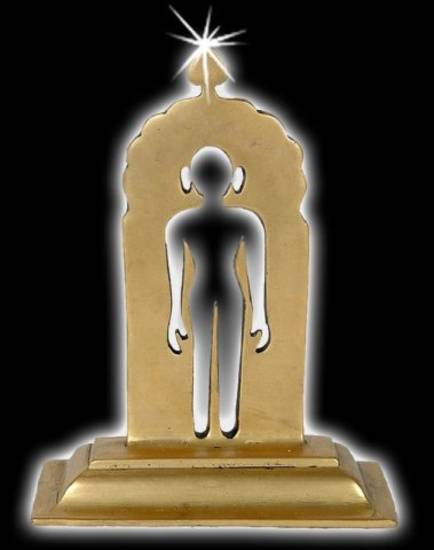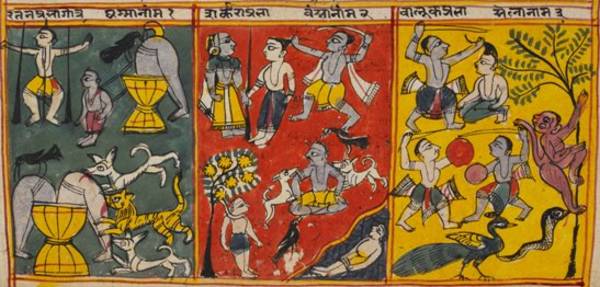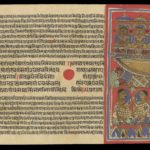Article: Soul
The Jain faith revolves around the notion of the soul – jīva – which can also be understood as sentience or consciousness. The ultimate objective of the Jain religion is for the soul to attain self-realisation, which is liberation – mokṣa – from the cycle of births.
The soul is a concept found in many religions but Jain beliefs about the soul or Self are very distinctive. For Jains there is an infinite number of individual souls. All souls are trapped by karmas in bodies within the cycle of rebirth until they reach liberation from the cycle of birth – saṃsāra. This occurs when a soul is free of all karmas and can realise its inherent attributes.
The innate qualities of the soul are obscured by karmas when the soul is embodied. The quantity and type of karmas bound to a soul stain it one of six colours. The soul’s spiritual level corresponds with its leśyā.
Produced by activities, whether mental or physical, karmas are either negative or positive but all bind to the soul. Activities come from attachment to the world, which must be conquered to progress spiritually. The different kinds of karma attach to the soul, influencing the type of body it is born into in various lifetimes. Souls can be born into all kinds of living beings, but only souls born into human bodies can attain emancipation, by following the teachings of the Jinas.
Liberated souls – siddhas – are perfected and realise all their innate qualities. They exist without bodies at the top of the universe, in perpetual bliss.
Jain notions about the soul are similar to those of other religious faiths that first developed in India, but there are some key differences.
Attributes
In Sanskrit, the soul or self is jīva – ‘that which is sentient or has consciousness’. The opposite of jīva is ajīva, which can be described as the absence of soul. Ajīva characterises non-living things. Both forms of matter make up the universe, according to Jain cosmology.
In Jain cosmology the soul is one of the three types of substance – dravya. It is non-material, not made up of atoms or molecules. In its pure condition, the soul does not have material properties of colour, odour, form and taste. It is a pure substance with:
The soul always has these innate qualities – guṇas – although karma may obscure them. The first two attributes together produce consciousness – caitanya. This awareness or sentience is jīva and distinguishes this non-physical substance from the other two substances – dravyas – in the universe.
There are infinite numbers of individual souls. The soul is either embodied or disembodied. Souls within bodies have karma bound to them, dooming them to be born and reborn within the cycle of birth until they can rid themselves of all karma. Souls that exist outside bodies are perfected souls, known as siddhas – liberated souls – because they are emancipated from the cycle of birth. This final liberation of the soul – mokṣa – is the ultimate objective of the Jain religion.
Some souls have the quality of abhavya, which means they lack the capability of achieving liberation. Most souls, however, are bhavya and can attain emancipation.
Karma and rebirths
Souls exist within bodies because they have karma bound to them. All souls are embodied at one stage, even those that have been liberated from the cycle of birth – saṃsāra – and are now perfect. To regain its original pure condition, the soul must rid itself of all karma by progressing spiritually.
There are many different types of karma, both positive and negative. Both kinds of karma limit and corrupt the soul, hiding its essential qualities and trapping it within the cycle of rebirth. Karma is both a product of the soul’s embodiment and a source of it.
Leśyā
Being born into many different bodies, with attachments to the world they live in and passions or emotions, means the soul gets karma bound to it. A soul’s level of spiritual development can be gauged by its leśyā.
Produced by the interaction between karma and soul, leśyā is a staining of the soul, making it certain colours. These six colours indicate spiritual level and have no bearing on the colour of the body.
A perfect soul has no karmas, so its inherent purity and clarity can be seen. As a soul develops spiritually, it gets lighter and brighter.
Attachment and karma
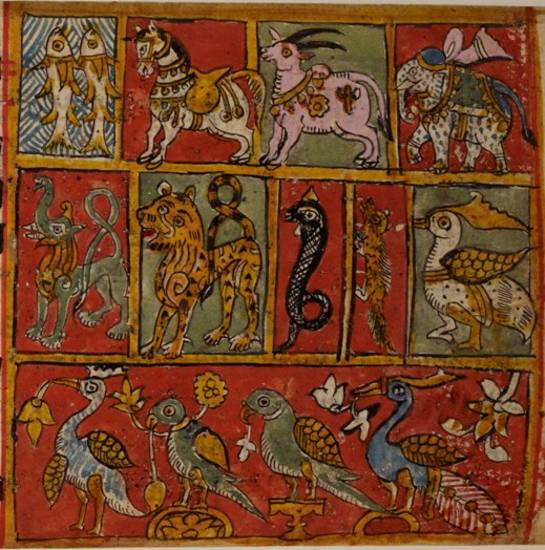
Five-sensed animals
Image by British Library © CC0 1.0 (Creative Commons Public Domain)
Karma is generated by activities, caused by attachments – kaṣāyas – to the world, which may be either negative or positive. Both types of attachments create karmas, which bind to the soul, weighing it down and obscuring its inherent attributes.
Karmas created in one lifetime or birth influence the later lives of the soul, such as:
- the type of living being it is born into
- its physical qualities
- its lifespan
- general experiences.
Thus lots of negative karma will result in birth as a creature in hell, an animal or a being with limited senses, such as an insect, plant or single-celled microscopic organism. Negative karmas are produced by actions such as deliberate violence. Positive karma brings about birth as a god or human being.
Whether negative or positive, all karmas bind to the soul. This is why Jains believe that complete detachment from the world is necessary to destroy existing karmas and avoid producing new ones. Self-control and detachment thus underlie exemplary Jain behaviour, such as non-violence and practising asceticism – tapas – which burns away karma.
Birth as a human being
Souls are found within all types of living beings, ranging from those with one sense to those with five. A soul contracts or expands to fill the available space inside a body, from a tiny, one-celled nigoda to a five-sensed blue whale.
Being born a human is vital for salvation because only human beings can reach omniscience and then liberation. It is rare, within the enormously long cycle of birth to be born a human being, so it is a good opportunity to make spiritual progress.
Guide to liberation
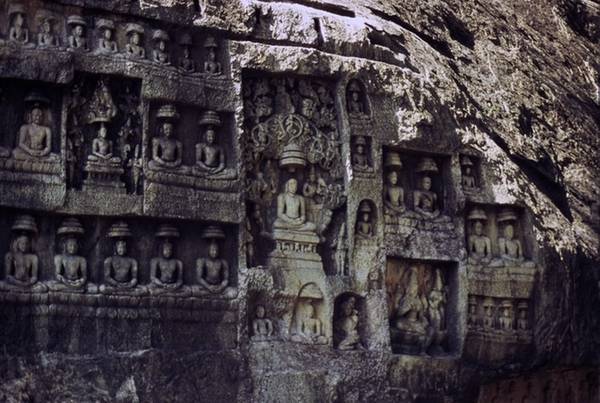
Carvings of Jinas
Image by Jennifer Howes © CC BY-NC 3.0
As found in the scriptures, the 24 Jinas preach the eternal truths of the universe and provide guidance on the correct mental attitudes and conduct to bring about spiritual progress.
As the soul travels up the ‘scale of perfection’ – guṇa-sthāna – it reaches levels of spiritual development where it destroys the karma attached to it and stops new karma from sticking to it. It can thus attain, in stages, perfect knowledge – omniscience – and finally liberation.
Liberated souls
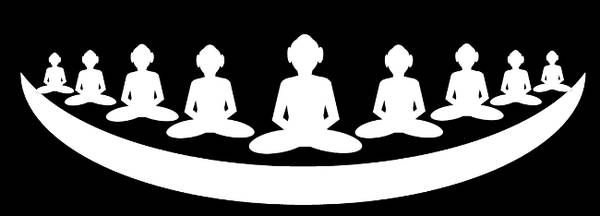
Siddha-śilā
Image by Anishshah19 © CC-BY-3.0
Souls emancipated from the cycle of birth are siddhas. They have reached perfection and are thus free of the flesh into which their karmas have bound them.
When they reach full spiritual development, souls are free of all karmas. This means that when the human being’s lifespan ends, fulfilling its āyus-karma, and the body dies, the soul leaves the body permanently. It regains its original purity, realises its true nature. Therefore, instead of being born into another body again, the perfected soul rises to the siddha-śilā.
The siddha-śilā is also known as the siddha-loka or īśat-prāgbhārā-bhūmi. It is a space at the top of the universe, in which all the siddhas dwell for ever. They remain separate beings here, each experiencing absolute bliss.
Other terms for siddha – perfect, liberated soul – are:
- Supreme Soul – paramātman
- god – deva.
Indian religions and the soul
Along with other religions that originated in India, such as Hinduism and Buddhism, Jains believe that souls:
- are trapped in the neverending cycle of rebirth – saṃsāra
- are reborn in different bodies according to the karma they have collected
- can only break out of the cycle of rebirth by being born a human being, achieving enlightenment and then, leaving the body behind, reaching liberation
- with karma attached to them can never be enlightened – the bondage of karma.
The Jain concepts of the soul and karma differ from those of the other Indian faiths, however. In Jainism souls are individual with the same innate qualities. They accrue karmas that are bound to them throughout the cycle of birth until they mature and fall away. Souls remain individual once they are perfected.
Followers of the Buddha do not believe in a soul in the same way as Jains and Hindus. The Buddha preached anatta – the doctrine of no soul – and that the cycle of birth involves a transfer of consciousness from one body to another, influenced by karma. Nirvāṇa is the term usually used for liberation or salvation – in which followers of the Buddha realise that there is neither self nor consciousness. It describes the extinguishing of the ‘fires’ of attachment, aversion and ignorance that cause suffering. Enlightened souls thus gain release from the cycle of births when they die – mokṣa – instead of another rebirth.
There is a variety of belief among Hindu traditions, although most Hindus believe in the soul or self – ātman – and liberation. Broadly, for Hindus ignorance of the true self or soul creates desire for and enjoyment of the world, which traps the soul in the cycle of birth. Karma comes from thoughts, words and deeds, and influences future lives. Between two births, the soul goes either to hell, to be punished for bad actions, or to heaven, where it enjoys rewards for good actions. Hindu mokṣa is the perfecting of the soul and release from the cycle of rebirths, although various schools differ on whether realisation of the soul can be achieved during or after life.
Reading
- Karma
Johannes Bronkhorst - Dimensions of Asian Spirituality series
University of Hawaiʻi Press; Honolulu, Hawai'i, USA; 2011
- The Jains
Paul Dundas - Library of Religious Beliefs and Practices series; series editor John Hinnels and Ninian Smart; volume 14
Routledge Curzon Press; London, UK; 2002
- The Jaina Path of Purification
Padmanabh S. Jaini - University of California Press; Berkeley, California USA; 1979
- ‘Bhavyatva and Abhavyatva: a Jaina Doctrine of Predestination’
Padmanabh S. Jaini - Collected Papers on Jaina Studies
Motilal Banarsidass; New Delhi, India; 2000
- Harmless Souls: Karmic Bondage and Religious Change in Early Jainism with Special Reference to Umāsvāti and Kundakunda
William J. Johnson - Lala Sundar Lal Jain research series; volume 9
Motilal Banarsidass; Delhi, India; 1995
- Commentary on Tattvārtha Sūtra of Vācaka Umāsvāti
Pandit Sukhlalji - translated by K. K. Dixit
L. D. series; volume 44
L. D. Institute of Indology; Ahmedabad, Gujarat, India; 1974
- Historical Dictionary of Jainism
Kristi L. Wiley - Historical Dictionaries of Religions, Philosophies, and Movements series; series editor Jon Woronoff; volume 53
Scarecrow Press; Maryland, USA; 2004
Links
- Jain beliefs about the soul
-
An overview of Jain beliefs about the soul on the BBC website, provided as part of the Religions section.
http://www.bbc.co.uk/religion/religions/jainism/beliefs/soul.shtml
- Jīva and Ajīva
-
Sadhvi Vishrut Vibha summarises the two central Jain principles of sentient and non-sentient substances in her 2007 book An Introduction to Jainism, provided on the HereNow4U website.
- Ātmavāda
-
Sadhvi Vishrut Vibha summarises the Jain doctrine of the soul in her 2007 book An Introduction to Jainism, provided on the HereNow4U website.
- Nature Of The Soul
-
In this chapter from Philosophical Foundations Of Jainism (An Introduction), Ācārya Mahāprajña of the Śvetāmbara Terāpanth sect discusses the soul. First published under the title of Jain I Darshan ke Mool Sutra, the book was translated by M. P. Lele under the guidance of Muni Mahendra Kumar ji and Muni Dulahraj ji. The translation is available online on the HereNow4U website.
Read more in the next chapter by clicking on an arrow or sliding the button along the scroll bar at the top and bottom of each page.
- Jainism, women and equality
-
BBC Religions provides a summary and brief discussion of the status of women in the Jain faith.
http://www.bbc.co.uk/religion/religions/jainism/beliefs/women.shtml
- The Doctrine
-
Colette Caillat, A. N. Upadhye and Bal Patil outline the central tenets of the Jain religion in this chapter from their 1974 work Jainism, including:
- the 'three gems'
- knowledge
- doctrine of 'truth from many viewpoints'
- tattvas
- soul
- karma
- leśyās
- cosmology
- cycles of time
- Jinas.
The online version is provided on the HereNow4U website.
- Doctrines of Jainism
-
In this chapter from his 1985 book, Paul Marett uses everyday language to explain the key points of Jain doctrine, including:
- karma
- soul
- five fundamental principles
- omniscience
- liberation.
The online version is available on the HereNow4U website.
- Holy symbols in worship
-
Taken from the side, this 2009 photo on Flickr captures a very holy and frequently found symbol in Jain worship. Created in rice grains as part of a ceremony, the symbol is in three parts. Considered from the bottom, they are:
- a svastika representing the four parts of the Jain community and four conditions of being
- three dots representing the three jewels of Jain doctrine
- a horizontal crescent with a dot above, which symbolises the liberated soul in the siddha-śilā.
- +
- aAbhavya
- aAbhinandana
- aAbhiṣeka
- aĀcāra
- aĀcārāṅga-sūtra
- aĀcārya
- aAchalbhrata
- aAḍhāī-dvīpa
- aAdharma
- aAdho-loka
- aAdhyayana
- aAdvaita Vedānta
- aĀgama
- aAghātīya
- aAghātīya-karman
- aAgnibhuti
- aAgra
- aĀhāra
- aAhiṃsā
- aAhimsa Day
- aAjita
- aAjīva
- aAkampit
- aĀkāśa
- aAkbar the Great
- aAkṣaya-tṛtīyā
- aAlauddin Khalji
- aAlbert Einstein
- aAllah
- aAlms
- aĀlocanā
- aAloka-ākāśa
- aAmāri
- aAmbikā or Kūṣmāṇḍinī
- aAnagāra
- aAnanta
- aAnarthadaṇḍa
- aAnaśana
- aAnekānta-vāda
- aAṅga
- aAniconism
- aAnojjā
- aAntarāla
- aAntarāya-karma
- aAṇu
- aAṇu-vrata
- aAnukampā
- aAnuprekṣā
- aAnusvāra
- aApabhraṃśa
- aAparigraha
- aAra
- aĀrambha
- aĀrambhaja
- aĀratī
- aArdhamāgadhī Prākrit
- aArhaṃ
- aArhat
- aArśana-āvaraṇīya-karma
- aĀrta-dhyāna
- aĀryikā
- aĀryikā Jñānamati
- aĀśātanā
- aĀścarya
- aAscetic
- aAsceticism
- aAshram
- aAspiration
- aĀsrava
- aAṣṭa-maṅgala
- aAṣṭāpada
- aAstikāya
- aAstrolabe
- aAsura
- aAtheism
- aAticāra
- aAtiśayakṣetra
- aAtithisaṃvibhāgavrata
- aĀtma-vāda
- aĀtman
- aAuṃ
- aAurangzeb
- aAuspicious
- aAusterity
- aAvadhāna
- aAvadhi-jñāna
- aĀvaraṇī-yakarman
- aAvasarpiṇī
- aAvatāra
- aAvidyā
- aAxiom
- aĀyāga-paṭa
- aĀyambil
- aĀyu-karma
- aĀyurveda
- bBabur
- bBāhubali
- bBaladeva
- bBālāvabodha
- bBandha
- bBasadi
- bBazaar
- bBhadrankarvijay
- bBhagavant
- bBhaktāmara-stotra
- bBhakti
- bBhale
- bBharata
- bBhāṣā
- bBhāṣya
- bBhaṭṭāraka
- bBhāva
- bBhāva-pūjā
- bBhāvanā
- bBhavana-vāsin
- bBhavya
- bBhavyatva
- bBhaya
- bBhoga-bhūmi
- bBhogopabhoga
- bBodhi
- bBollywood
- bBrahmā
- bBrahma-deva
- bBrahmacārī
- bBrāhmaṇa
- bBraj Bhāṣā
- bBright fortnight
- bBritish Raj
- bBuddha
- bBuddhi-sagar
- bBuddhism
- bBuddhist
- cCaitya
- cCaityavāsin
- cCakravartin
- cCakreśvarī
- cCāmara
- cCandanā
- cCandragupta
- cCandraprabha
- cCanon
- cCāritra
- cCāritramohanīya-karman
- cCarũrī
- cCaste
- cCaturvidha-saṅgha
- cCaturviṃśati-stava
- cCāturyāma
- cCE
- cCelibacy
- cCha
- cChadmastha
- cChastity
- cCheda-sūtra
- cChristian
- cChristianity
- cClergy
- cCloning
- cColophon
- cCommentary
- cConch
- cConfession
- cCongregation
- cConsecration
- cCosmology
- cCremation
- cCrore
- cCult
- cCūrṇi
- dDādā-guru
- dDalit
- dDāna
- dDaṇḍa
- dDark fortnight
- dDarśana
- dDarśanamohanī-yakarman
- dDaśa-lakṣaṇa-parvan
- dDeity
- dDelhi Sultanate
- dDerāsar
- dDeśāvakāśika-vrata
- dDetachment
- dDevanāgarī
- dDevānandā
- dDevarddhi-gani
- dDevotee
- dDhamal
- dDhanuṣ
- dDhāra
- dDharma
- dDharma-dhyāna
- dDharma-sāgara
- dDharmastikaya
- dDhātakīkhaṇḍa
- dDholak
- dDhyāna
- dDiaspora
- dDig-vrata
- dDigambara
- dDīkṣā
- dDisciple
- dDīvālī
- dDivya-dhvani
- dDNA
- dDoctrine
- dDogma
- dDonor
- dDoṣa
- dDravya
- dDravya-pūjā
- dDrone
- dDuṣamā
- dDuṣamā-duṣamā
- dDuṣamā-suṣamā
- dDveṣa
- dDvīpa
- eEast India Company
- eEightfold Path
- eEkānta-vāda
- eEkendriya
- eElder
- eElders
- eEschatology
- eEtc up to
- fFarmān
- fFast
- fFatehpur Sikri
- fFestival
- fFestschrift
- fFiruz Shah
- fFly-Whisks
- fFolio
- fFour Noble Truths
- gGaccha
- gGaṇa
- gGaṇadhara
- gGanadharavada
- gGaṇeśa
- gGaṇin
- gGarba
- gGarbha
- gGarbha-gṛha
- gGaruḍa
- gGati
- gGene
- gGenomics
- gGhātī-yakarman
- gGhātīya
- gGhaznavid
- gGhiyasuddin Tughlaq
- gGhurid
- gGloss
- gGotra-karma
- gGujarāt
- gGujarati
- gGuṇa
- gGuṇa-sthāna
- gGuṇa-vrata
- gGupti
- gGuru
- gGuruṇī
- hHagiography
- hHajj
- hHaṃsa
- hHaribhadra
- hHariṇaigameṣin
- hHasta
- hHeresy
- hHiṃsā
- hHindi
- hHindu
- hHinduism
- hHīravijaya
- hHoroscope
- hHrīṃ
- hHumayun
- hHymn
- iIconoclasm
- iIconography
- iIdol
- iIndian Independence
- iIndology
- iIndra
- iIndrabhūti Gautama
- iIndriya
- iInitiation
- iIntercession
- iInvocation
- iIQ
- iIslam
- iIslamicate
- iIṣṭadevatā
- iĪśvara
- jJagat
- jJahangir
- jJain
- jJaina Devanāgarī
- jJaina Śaurasenī
- jJaina-dharma
- jJainaśāsana
- jJainness
- jJaisalmer
- jJamāli
- jJambū-dvīpa
- jJames Burgess
- jJanma
- jJanma-kalyāṇa
- jJarā
- jJāti
- jJina
- jJina-āgama
- jJina-bhavana
- jJina-bimba
- jJina-mātā
- jJinacandra-sūri
- jJinadatta
- jJinaprabha
- jJīva
- jJñāna
- jJñāna-āvaraṇīya-karma
- jJñāna-āvarṇiya
- jJñānsundar
- jJyotiṣka
- kKāla
- kKālakācārya-kathā
- kKālidāsa
- kKalpa-sūtra
- kKalpa-vṛkṣa
- kKalyāṇaka
- kKalyanvijay
- kKamaṇḍalu
- kKamaṭha
- kKarma
- kKarma-bhūmi
- kKarma-grantha
- kKarma-prakṛti
- kKarma-vāda
- kKarmon
- kKarnataka
- kKaṣāya
- kKathā
- kKāvya
- kKāya
- kKāyotsarga
- kKeśa-loca
- kKetu
- kKevala-jñāna
- kKevalin
- kKhalji
- kKharatara-gaccha
- kKnowledge
- kKriyā
- kKriyā-vāda
- kKṛṣṇa
- kKṣamā-śramaṇa
- kKṣapakaśreṇi
- kKṣatriya
- kKṣullaka
- kKulakara
- kKundakunda
- kKunthu
- lLabdhi
- lLaity
- lLakh
- lLāñchana
- lLands of Action
- lLaukāntika
- lLavaṇa-samudra
- lLeśyā
- lLiṅga
- lLinguistics
- lLoka
- lLoka-ākāśa
- lLoka-puruṣa
- lLoka-vāda
- lLotus
- lLotus lake
- mMadhya-loka
- mMahā-videha
- mMahā-vrata
- mMahābhārata
- mMahāmastakābhiṣeka
- mMāhārāṣṭra
- mMāhārāṣṭrī Prākrit
- mMahattarā Yākinī
- mMahāvīr Jayantī
- mMahāvīra
- mMakāra
- mMakkhali Gośāla
- mMalli
- mMāna-stambha
- mManaḥ-paryāya-jñāna
- mMaṇḍala
- mMaṇḍapa
- mMandit
- mMaṅgala
- mMantra
- mMantras
- mManuṣya-loka
- mMarāṭhī
- mMārgaṇā
- mMartyr
- mMarudevī
- mMaṭha
- mMati-jñāna
- mMauryaputra
- mMecca
- mMendicant lineage
- mMetarya
- mMiracle
- mMithyādṛṣṭi
- mMohandas Gandhi
- mMohanīya-karma
- mMokṣa
- mMonastic order
- mMonasticism
- mMonk
- mMonotheism
- mMosque
- mMount Meru
- mMount Sammeta
- mMṛgāvatī
- mMughal
- mMuhammad
- mMuhammad bin Tughlaq
- mMuhpattī
- mMūla-sūtra
- mMūlaguṇa
- mMumbaī
- mMuni
- mMunisuvrata
- mMurad Bakhsh
- mMūrti-pūjaka
- mMuslim
- mMysticism
- nNābhi
- nNāga-kal
- nNāgapurīya Tapā-gaccha
- nNāgarī
- nNāma-karma
- nNamaskāra-mantra
- nNami
- nNandīśvara-dvīpa
- nNandivardhana
- nNandyāvarta
- nNāraka
- nNāraki
- nNasalisation
- nNātha
- nNavrātrī
- nNaya-vāda
- nNemi
- nNidāna
- nniggaṃthāṇa vā 2
- nniggaṃtho vā 2
- nNigoda
- nNihnava
- nNikṣepa
- nNirgrantha
- nNirjarā
- nNirvāṇa
- nNiryukti
- nNiṣidhi
- nNitya
- nNiyati
- nNo-kaṣāya
- nNudity
- nNun
- oOcean of milk
- oOmniscience
- oOrdination
- ppa°
- pPadmaprabha
- pPadmāsana
- pPadmāvatī
- pPādukā
- pPalanquin
- pPalette
- pPañca-muṣṭi
- pPāṇḍava
- pPaṇḍit
- pPandit Dalsukh D. Malvania
- pPandit Sukhlalji
- pPāṇipātra
- pPāpa
- pParamātman
- pParameṣṭhin
- pPāraṇā
- pParigraha
- pPariṇāma
- pParīṣaha
- pParokṣa
- pPārśva
- pPārśvanātha
- pParyāya
- pParyuṣaṇ
- pPaṭa
- pPatan
- pPātra
- pPenance
- pPersian
- pPhala
- pPhilology
- pPicchikā
- pPilgrimage
- pPīr
- pPolymath
- pPoṣadha
- pPossession
- pPothī
- pPrabhas
- pPradakṣiṇā
- pPradeśa
- pPrākāra
- pPrakīrṇaka-sūtra
- pPrākrit
- pPramāda
- pPramukhā
- pPrati-vāsudeva
- pPratikramaṇa
- pPratimā
- pPratiṣṭhā
- pPratyākhyāna
- pPratyakṣa
- pPravacana
- pPrāyaścitta
- pPrayer
- pPre-modern
- pPreach
- pPredestination
- pProtestant
- pProvenance
- pPudgala
- pPūjā
- pPujārī
- pPukharavara-dvīpa
- pPuṇya
- pPūrva
- pPuṣkara-dvīpa
- pPuṣpadanta
- pPyre
- qQur’an
- rRāga
- rRāhu
- rRainy season
- rRajasthan
- rRajasthani
- rRājimatī
- rRajoharaṇa
- rRajput
- rRāma
- rRāmāyaṇa
- rRangoli
- rRās-garbā
- rRasa
- rRathanemi
- rRatna-traya
- rRātri-bhojana
- rRaudra-dhyāna
- rRecto
- rRelic
- rRenunciation
- rRetroflex
- rRevatī
- %Ṛg-veda
- rRite
- rRosary
- %Ṛṣabha
- %Ṛṣabhanātha
- rRupee
- sSaciyā Mātā
- sSādhu
- sSādhvī
- sSāgāra
- sSaint
- sŚaivaism
- sŚaka-saṃvat
- sSallekhanā
- sŚalya
- sSamacatuṣṭha
- sSamādhimaraṇa
- sSamaṇi
- sSāmarambha
- sSamavasaraṇa
- sSāmāyika
- sSaṃbhava
- sSamiti
- sSaṃjñā
- sSaṃkalpaja
- sSaṃsāra
- sSamudghāta
- sSaṃvara
- sSaṃvega
- sSamyak-cāritra
- sSamyak-darśana
- sSamyak-jñāna
- sSamyaktva
- sSaṃyama
- sSanctuary
- sSandalwood
- sSaṇgha
- sSanskrit
- sSant
- sŚānti
- sSapta-bhaṅgi-naya
- sSārambha
- sSarasvatī
- sSarvajña
- sSāsan-devi
- sŚāsana-devatā
- sŚāstra
- %Ṣaṭ-jīvanikāya
- sSatī
- sSatīmātā
- sSatya
- sSchism
- sScribe
- sScripture
- sSect
- sSecularism
- sŚenāī
- sSermon
- sŚeṣavatī
- sSevā
- sSeven fields of donation
- sShah Jahan
- sShantidas Jhaveri
- sShrine
- sSiddha
- sSiddha-śilā
- sSiddhacakra or Navadevatā
- sSiddhānta
- sSiddhārtha
- sSiddhi
- sSikh
- sSikhism
- sŚikṣā-vrata
- sŚīla
- sSin
- sSindh
- sŚītala
- sŚiva
- sSkandha
- sSomanatha
- sŚraddhā
- sŚramaṇa
- sŚrāvaka
- sŚrāvakācāra
- sŚrāvikā
- sŚreyāṃsa
- sŚrī
- sŚrīvatsa
- sŚruta-jñāna
- sŚruta-pañcamī
- sSthānaka-vāsin
- sSthāpanācārya
- sSthāvara
- sSthavira
- sSthiti
- sStrīmukti
- sStūpa
- sSubcontinent
- sSudarshana
- sŚuddhi
- sSudharma
- sŚūdra
- sSufism
- sSukha
- sŚukla-dhyāna
- sSulasā
- sSultan
- sSumati
- sSundarśrī
- sSupārśva
- sSūri
- sSuṣamā
- sSuṣamā-duṣamā
- sSuṣamā-suṣamā
- sSūtra
- sSuyam me ausam! Tenam bhagavaya evamakkhayam
- sSvādhyāya
- sSvāhā
- sSvastika
- sŚvetāmbara
- sŚvetāmbara Terāpanthin
- sŚvetāmbaras
- sSwan
- sSyād-vāda
- tTabla
- tTantra
- tTapā-gaccha
- tTapas
- tTāraṇ Svāmī Panth
- tTattva
- tTattvārtha-sūtra
- tTemple
- tTemple-city
- tThe Enlightenment
- tTheology
- tThree worlds
- %Ṭīkā
- tTilaka
- tTīrtha
- tTīrthaṃkaranāma-karman
- tTīrthankara
- tTransliteration
- tTrasa
- tTrasa-nāḍī
- tTriśalā
- tTriṣaṣṭi-śalākā-puruṣa-caritra
- tTti bemi
- tTughlaq
- tTunk
- uUdumbara
- uUniversal History
- uUpādhyāya
- uUpāṅga
- uUpaniṣads
- uUpāsaka
- uUpasarga
- uUpāśraya
- uŪrdhva-loka
- uUtsarpiṇī
- uUttarādhyayana-sūtra
- vVāhana
- vVaimānika
- vVairāgya
- vVaiṣṇava
- vVaiśramaṇa
- vVaiśya
- vValabhī
- vVanaspatikāya
- vVandana
- vVaṇik
- vVarṇa
- vVāsudeva
- vVāsupūjya
- vVayubhūti
- vVeda
- vVedanīya-karma
- vVegetarianism
- vVehicle
- vVernacular
- vVerso
- vVidyā
- vVidyā-devī
- vVihāra
- vVijñapti-patra
- vVikrama-saṃvat
- vVikṛti
- vVimala
- vVinaya
- vVipāka
- vVirji Vora
- vVirodhaja
- vVīrya
- vVisarga
- vViṣṇu
- vVītarāga
- vVizier
- vVotive
- vVow
- vVrata
- vVS
- vVyakta
- vVyantara
- vVyasana
- yYakṣa
- yYakṣī
- yYantra
- yYaśoda
- yYaśovijaya
- yYati
- yYātrā
- yYoga
- yYoginī
- yYojana


